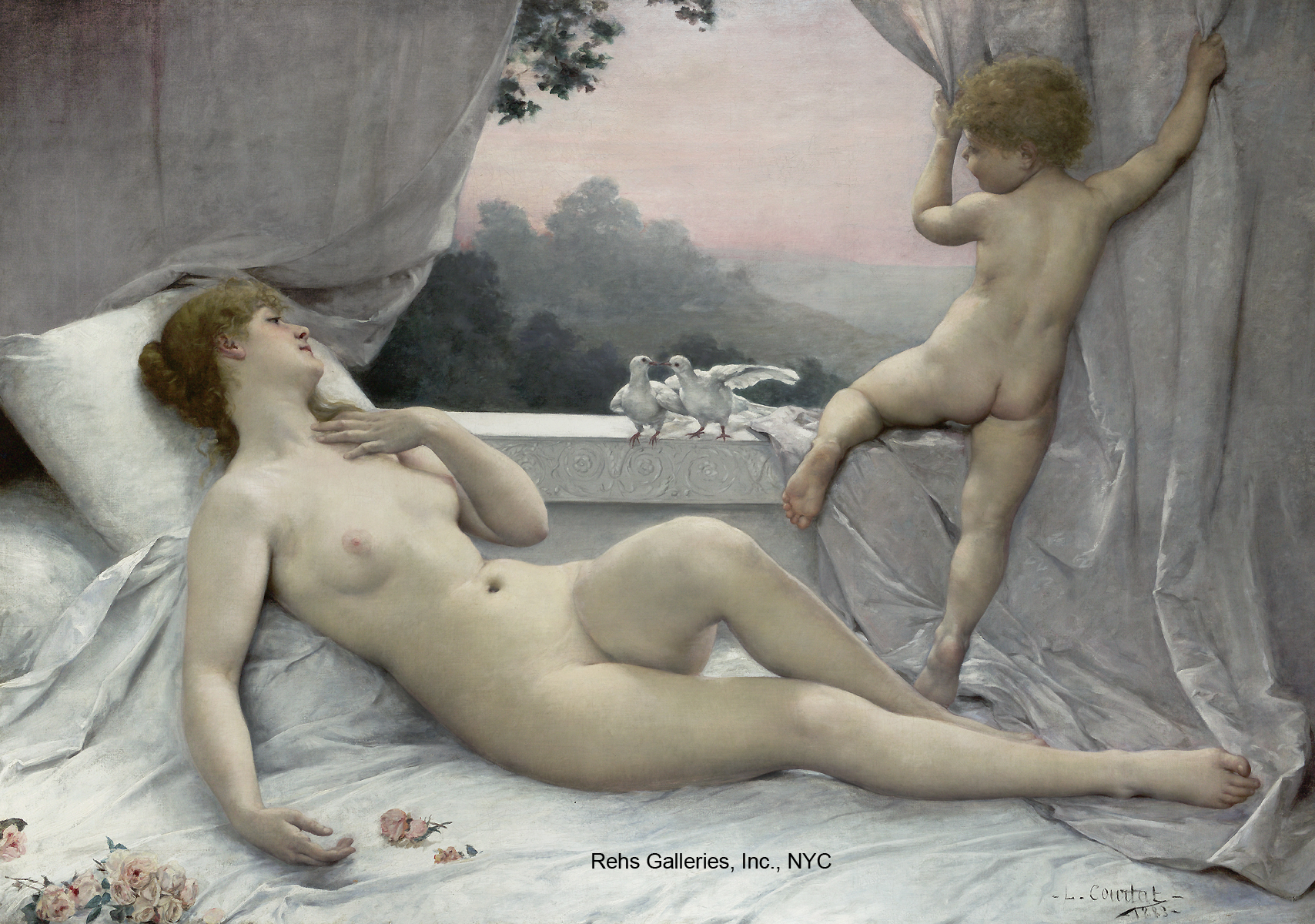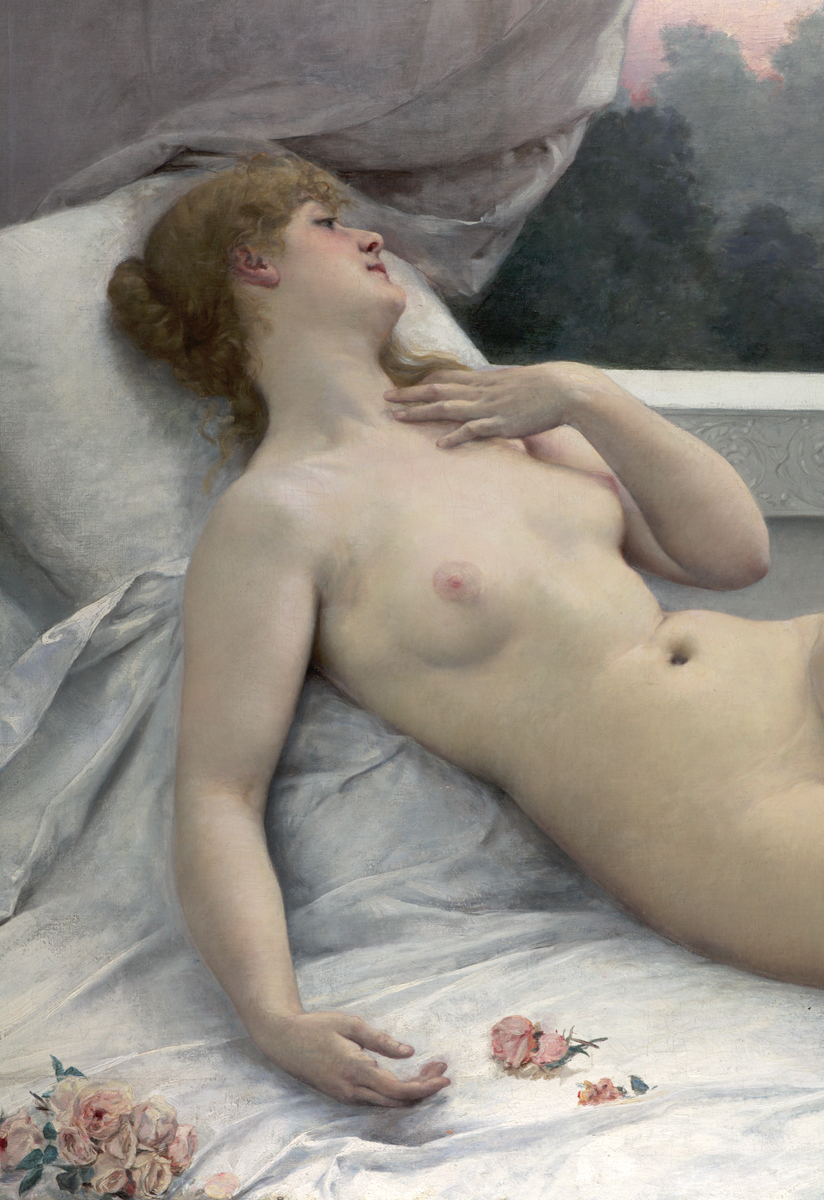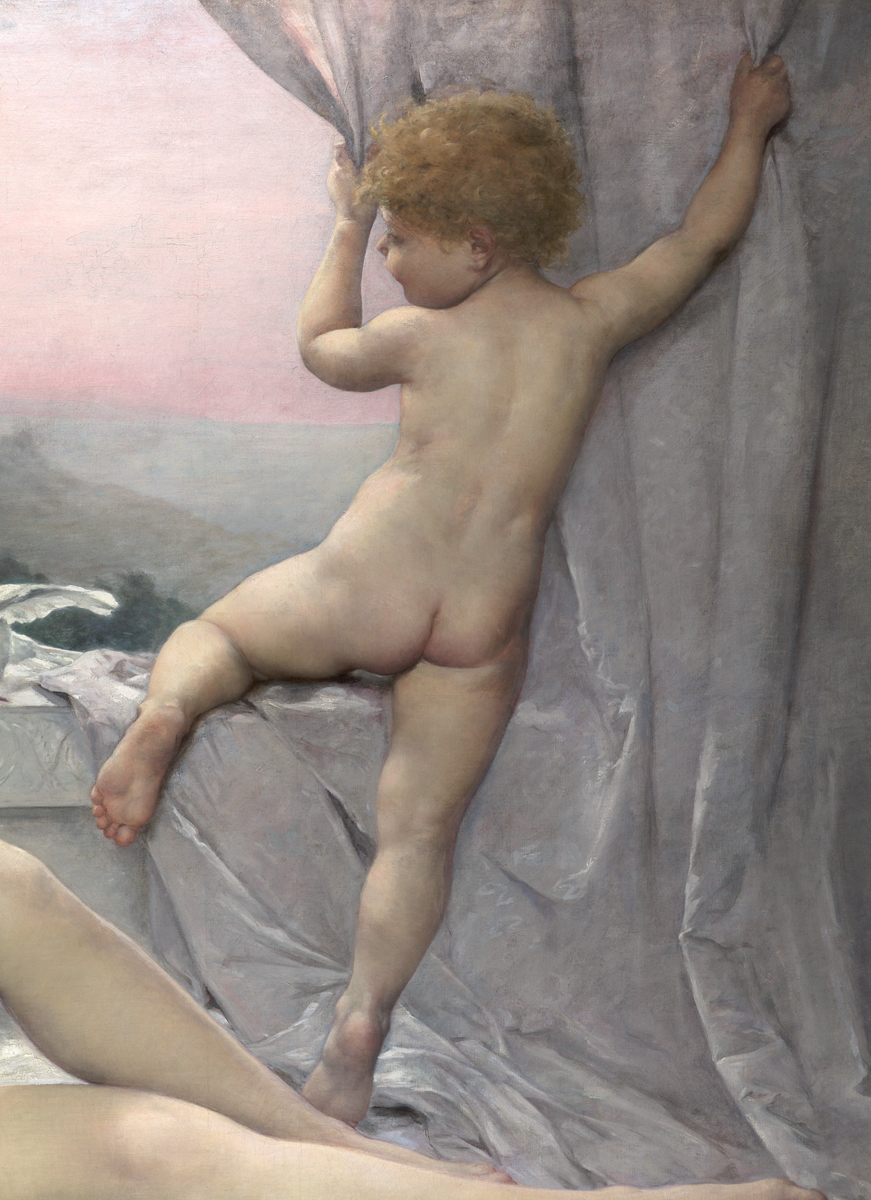Louis-Joseph Courtat
(1847 - 1909)
Le Réveil de Vénus (The Awakening of Venus)
Oil on canvas
57 3/4 x 81 inches
Signed and dated 1883
BIOGRAPHY - Louis-Joseph Courtat (1847 - 1909)
Louis-Joseph Courtat was born in Paris on September 6, 1847, only a few months before Europe erupted in revolution. Beginning in Sicily in January 1848, monarchies in France, Prussia and the Austrian Empire came under attack, ultimately resulting in some form of lasting democratic reform in each case. In France, Parisians took to the streets on February 22,1848, building barricades in the streets to protest the corruption of the monarchy; four days later, a provisional government was established and the “citizen king” Louis-Philippe abdicated. The Second Republic had begun. Although it would last barely four years, it marked the continuing progress toward democracy that began with the French Revolution of 1789. Like all of his generation, Courtat’s life would be marked by revolutions not only in 1848, but again in 1871-72 and by the extraordinary social changes brought about by industrialization.
Although little is known of Courtat’s childhood, he was studying with the painter Alexandre Cabanel (1823-1889), who began teaching at the Ecole des Beaux-Arts in 1864. It is likely that the young Courtat was one of Cabanel’s earliest pupils at the Ecole. The 1860s was a tumultuous decade in the Paris art world as the Realist painters challenged both neoclassicism and romanticism that had dominated the first half of the century; simultaneously, the emerging generation of younger Realists began incorporating Japanese elements and photographic techniques into their work. When the official Salon juries refused to accept two-thirds of the paintings submitted for consideration in 1863, the emperor Napoleon III established an alternative exhibition so that the people could judge the art for themselves. Known today as the Salon des refusés, this proved to be a watershed moment in the development of modernism, as the works of Edouard Manet, James McNeill Whistler, Camille Pissarro, and Johan Jongkind were introduced to a cross-section of the Parisian public. The controversy that ensued highlighted the “new art” but also provoked considerable hostility from advocates of classical academic painting such as Cabanel.
As a young artist, Courtat clearly chose to follow in the footsteps not only of his mentor Cabanel, but also of J.-A.-D. Ingres (1780-1867), the leader of French neoclassicism in the nineteenth century. As late as 1882, Courtat was still making copies of Ingres’ paintings such as Odalisque, executed in his own visual language but clearly paying tribute to the work of the earlier painter. Like the artists he admired, Courtat won the Prix de Rome and left Paris to study in Rome sometime around 1870. The exact dates of his stay in Rome are uncertain, but he made his Salon debut in 1873, just as France was emerging from the disasters of the Franco-Prussian War and the Paris Commune. He met with immediate success, receiving a third class medal for his work that year.
In 1874, Courtat’s work was again recognized with the third class medal at the Salon and in 1875, his painting of Léda received a first class medal. The influence of Cabanel is immediately evident in the languorous nude figure of Leda stretched out near a lake where Zeus, in his guise as a swan, can swim over to pay court to her. This large painting was purchased by the state and exhibited in the Musée du Luxembourg along with paintings by other living artists. With this official recognition, Courtat was identified as a promising young painter whose future success was increasingly assured. [i] Three years later, in 1878, another Salon painting, an allegory of Spring, was also purchased by the French government. [ii]
From his Salon debut in 1873 until 1890, Courtat exhibited at the Paris Salon without fail. Many of these paintings were variations on the theme of the reclining nude woman, often titled simply “Nude Bather”. As the years passed, these canvases became increasingly naturalistic, employing a more impressionistic brushstroke as well as models that were clearly contemporary women; in other words, the painter seems to have grown less concerned with depicting an ideal classical archetype.
Courtat’s work for the Salon also included mythological and allegorical canvases, often featuring images of Venus and Cupid or nymphs in the woods. Occasionally, he depicted biblical subjects such as Mary Magdalene at prayer or the Old Testament servant, Hagar. The public and critical reception of these paintings was generally positive. In 1888, for example, Courtat’s Salon submission, Nymphe des bois, was illustrated in the prestigious Salon Illustré. [iii]
Personal information about Courtat’s life is scant, but his home address is recorded in the Salon catalogues during the 1880s as Rue Boissonade, 6, an elegant Haussmann-era Beaux-arts apartment building in the Montparnasse neighborhood of Paris. The artist seems to have enjoyed a comfortable life in what was then the middle-class 14th arrondissement.
In addition to his Salon paintings, Courtat developed a thriving practice as a portraitist and occasional genre painter. His domestic genre scenes often feature children at play or engaged in ordinary daily life. The frequent appearance of one particular young girl as a model may also hint at the presence of a daughter; and perhaps the woman shown toweling the girl in After the Bath is his wife. Other genre paintings are set in the French countryside, such as Jeune femme allongée dans le pré, where again the influence of naturalism is fully present in both the subject matter and the looser, more fluid brushwork.
Courtat’s portraiture ranges from commissioned works to what might be termed “historical portraiture” of celebrities. This type of image serves a documentary purpose that would soon be eclipsed as photography increasingly assumed that role by the 1870s. Portrait of Mademoiselle George illustrates this point. The sitter was a well known actress, Marguerite Joséphine Weimer George (1787-1867) who was famous throughout Europe in the first half of the nineteenth century, both for her beauty and for her love affairs with Napoleon and the Duke of Wellington. By the time of Courtat’s portrait, she had already been celebrated in paint by François Gérard and Louis-Jean-François Lagrenée and in prose by Théopile Gautier, who compared her to the bas-reliefs of goddesses on the Greek temple at Aegina. [iv] Courtat’s canvas was undoubtedly based on another painting or possibly a photograph; Mlle George would have been quite elderly by the time he painted her. It is also possible that this was a memorial portrait commissioned after her death in 1867. [v]
Courtat continued to exhibit at the annual Salon until 1890. Whether he stopped painting at that time or simply turned his attention to other exhibition venues is unknown. He died in Paris in 1909.
By: Janet Whitmore, Ph.D.
Selected museums
Musée des Ursulines, Mâcon, France
Musée d’Orsay, Paris
[i] Courtat’s Odalisque has been exhibited several times in recent years, both as an example of Orientalism and as a representative image of academic art under the Third Republic. Exhibitions have included: L'Orient Express, Institut du Monde Arabe, Paris, 2014; Paul Delvaux. Aux sources de l'oeuvre, l'Espace Bellevue, Biarritz, 2003-04; and Les chefs-d'oeuvre de nos musées à l'aube de l'impressionnisme en 1874 à Chalon sur Saône et Mâcon, Mâcon,1974-75.
[ii] Dupont Vicars, editor, Master Paintings of the World (Chicago:The White City Art Co., 1902) 161.
[iii] Henry Fouquier, Salon Illustré (Paris: Ludovic Baschet, Librairie d’art, 1888) 506.
[iv] Théophile Gautier, Les Belles Femmes de Paris (Paris: Au Bureau, 1839).
[v] According to Thieme-Becker (1996), this painting hung in the foyer of the Odéon Theatre in Paris.
| AVAILABLE WORKS | ||




